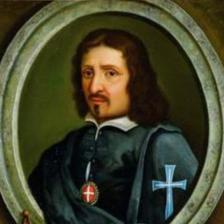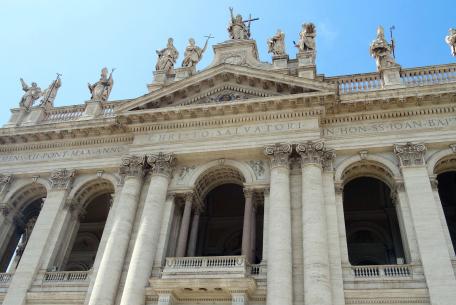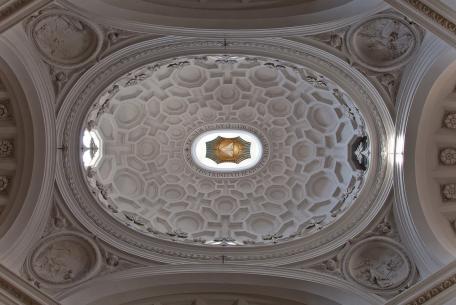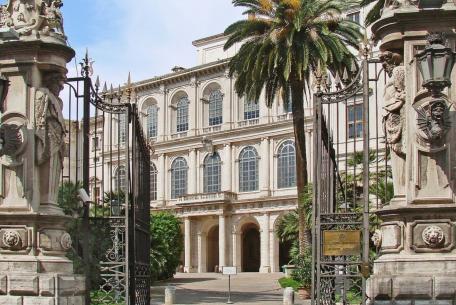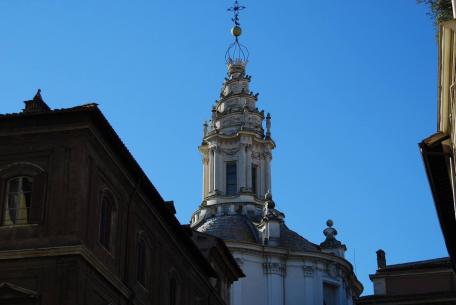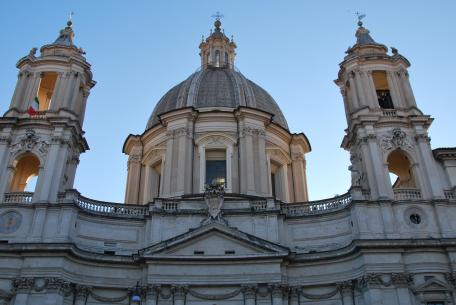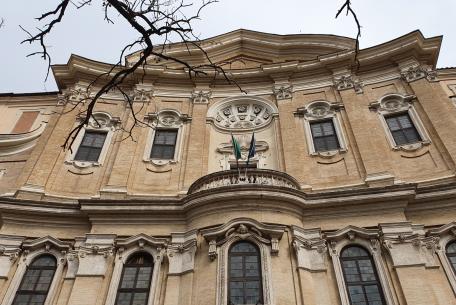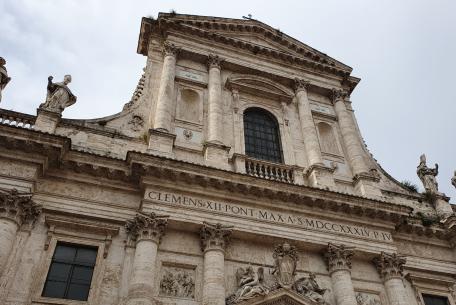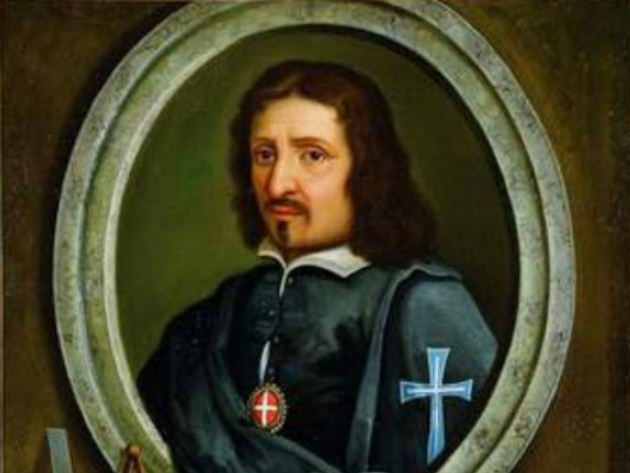
The architect Francesco Castelli, known as Borromini, was as shy and suspicious as highly skilled and one of great protagonists of Baroque art.
Filippo Baldinucci wrote about him “… solito di patir molto d’umore malinconico…” (ndt. he often suffers from melancholy mood).
He was born on 25th September 1599 in Bissone, in Ticino Canton. He left his hometown to train as a stonecutter and marble carver in the construction site of Milan’s Cathedral. Here, the artist learned a lot about various styles ranging from the monumental Romanesque style to the slender vertical Gothic architecture, developing excellent creative and technical skills.
Apparently, he came to Rome for the first time in 1619, when he was called to work as a stone carver in the large Fabbrica di San Pietro and found himself in the middle of a great artistic fervour. He worked on the construction of Saint Peter’s Basilica with the architect Carlo Maderno, his fellow citizen and distant relative, who recognized the extraordinary talent of the young artist and took him under his wing, entrusting him with various interventions in Saint Peter’s Basilica, in the Church of Sant’Andrea della Valle, and Palazzo Barberini.
Because of his intense bond and strong reverence for Maderno, Borromini expressed a wish to be buried next to his master’s grave. In 1629, after Maderno’s death, Borromini became assistant to the great and famous artist Gian Lorenzo Bernini, with whom he often clashed in the following years, but who more than any other initiated him to his debut as an independent architect. However, after a short cooperation during the construction of the “Saint Peter’s Baldacchino” and to end the works of Palazzo Barberini, the two artists took different paths.
The misunderstood genius Francesco Borromini immediately proved to be a skilled specialist: he introduced concave and convex lines, elliptical shapes and forced perspectives in San Carlo alle Quattro Fontane (1634-67).
Sant’Ivo alla Sapienza (1642-60), today considered the highest expression of Baroque style and one of the best examples in the history of architecture, remains the work where Borromini showed off all his genius skills. Borromini’s architectural dynamic style can be admired in several important buildings in Rome, like Oratorio dei Filippini (1637-41), Collegio di Propaganda Fide (1644-47) and the Church of Sant’Agnese in Agone (1653- 57).
Borromini’s professional life ended with the rise of the new pope Alexander VII Chigi and the end of a series of commis sions. He was overcome with despair and burned most of his drawings, stabbed himself in the chest and died, after a few days of agony, on August 3, 1667. He is buried next to his master Maderno in the monumental Church of San Giovanni dei Fiorentini.
Download here the full itinerary
Basilica di San Giovanni in Laterano
Piazza di San Giovanni in Laterano
Saint John in Lateran, centre of the pope’s power for over a millennium, is the most ancient Basilica in Rome and can be considered Rome’s cathedral. The Basilica was restored several times over the centuries but one of the most significant renovations is due to pope Innocent X Pamphilj, who entrusted Borromini with the reconstruction of the interior on the occasion of the Jubilee in 1650. Borromini decides to reorganize the existing spaces and structures, in the central nave and in the side ones, according to the Baroque taste. In the central nave, the artist incorporates the columns in majestic pillars that alternate with arches above which, the windows interchange with oval frames. He also decides to curve the counter facade wall, and to round the corners so that the space becomes all one with the nave walls. Twelve aediculas hosting the statues of the twelve apostles are also placed in this same nave. Moreover, Borromini changes place to the funeral monuments in the various chapels of the side naves in order to emphasize the Baroque style. Saint John in Lateran experience represents Borromini’s first challenge to change the asset of huge spaces as he succeeds in creating a solemn and harmonious environment, admirable example of balance.
Chiesa di San Carlo alle Quattro Fontane
Via del Quirinale, 23
San Carlo alle Quattro Fontane, fondly called by the Romans San Carlino because of its small dimensions, is one of the most important Baroque churches, yet, it is often inexplicably neglected. One of the most original works by Francesco Borromini, it was skilfully planned for the Trinitarians. Borromini started it in 1638 but died before ending it. Its striking, slender, curvilinear facade is divided into six units, the niche above the portal hosts San Carlo orante. The oval plan interior is characterized by harmonious, curvy walls hosting little chapels. The elliptic dome is finely decorated by hexagons, octagons and crosses, the dimensions of which get progressively smaller towards the small lantern, creating deeper height. Adjacent to the church is the small octagonal Cloister divided into two orders. Arches are supported by columns in the lower floor, while the above loggia is decorated with balustrades alternating straight and reverse, as a decorative element.
Palazzo Barberini
Via delle Quattro Fontane, 13
Located on the southern wing of Palazzo Barberini, is the original Helical Staircase (1633-34) inspired by the famous staircase of Palazzo Farnese in Caprarola. it is characterized by an oval plan, an architectural trick allowing a more comfortable climb, and twelve double columns, decorated at their ends by small bees, the Barberini heraldic symbol. The oculus on the top and the windows of the facade are the only source of light. The staircase, which was initially supposed to end with a free flight, was subsequently raised so that it could reach the third floor where, once, cardinal Barberini’s big library was located. The artist also made the doors of the hall of honour and the windows, placed next to the central arcade, which recall those made by Carlo Maderno for Saint Peter’s Basilica, only more original.
Palazzo di Propaganda Fide
Via di Propaganda, 48
The Palace takes its name from the College of Propaganda Fide, established in 1622 as a place where to study and prepare young religious people for the work of evangelization. Gian Lorenzo Bernini starts the works building the brick facade on the side of Piazza Mignanelli. In 1644 Borromini replaces Bernini in the construction of the Palace at the behest of pope Innocent X restoring the side facade which overlooks Via di Propaganda. He skilfully uses the pilasters that mark the surface enriched with windows with imposing trabeations. Typical of Borromini’s style is the rhythm impressed on the buildings through the continuous alternation of concave and convex spaces that culminate with the large entrance portal in the centre. The master’s contribution is also found in the interior of the Palace. Crossing the portal, you can visit the Chapel of the Three Kings, initially built by Bernini, then modified by Borromini who designed a rectangular plan and an original vault with intertwined arches.
Chiesa di Sant’Andrea delle Fratte
Via di Sant’Andrea delle Fratte, 1
Going down via di Capo le Case, you will be fascinated by the vision of the extraordinary bell tower of Sant’Andrea delle Fratte, a singular example of Borromini’s mastery. The square based bell tower develops on two levels: the lower one is characterized by capitals composed by Erme, while the upper level is characterized by angels, inspired by the Greek Caryatids. Above all are the flaming torches and spirals, which support a crest with a buffalo, symbol of the client family, and a pointed crown. Borromini also builds the high square drum that supports the dome and designs the apse inside the church.
Palazzo Carpegna
Piazza dell’Accademia di San Luca, 77
Built at the end of the XVI century, this Palace initially belonged to Vainis family from Imola, then went to Carpegna family whose ambitious aim was to realize his prestigious family residence. Between 1643 and 1647, Borromini was called to expand and restore the building. In addition to the internal portico and courtyard, it is important to mention the internal entrance portal he designed, as an extraordinary creative way of “hiding” a helical ramp. At the top of the portal is the head of Medusa, between two wings and a shell, from which two cornucopias, lying on columns, descend. Between the cornucopias and the capitals various fruits of the earth and the face of a child are reproduced, symbols of luck and fertility.
Chiesa di Sant’Ivo alla Sapienza
Corso del Rinascimento, 40
A few steps from Piazza Navona, Sant’Ivo alla Sapienza church (1642-60) is considered one of the most spectacular works by Francesco Borromini. The artist showed off all his imagination and technical skills to build it, creating a star-shaped structure, derived from the intersection of two triangles whose corners are rounded and replaced by concave and convex surfaces. Once inside the church you will be fascinated by its light curvilinear structure, highlighted by the candid colour of the walls and by the vertical unique shape of the dome. True protagonist of this incomparable building in Rome, is the dome that stands out majestically over the entire Rione Sant’Eustachio, raising its spiral-shaped lantern as a headlamp for the faithful.
Chiesa di Sant’Agnese in Agone
Piazza Navona
The church of Sant’Agnese in Agone stands on the site where, according to the tradition, a young Christian, Agnese, was martyred during Diocletian’s reign. The first church was dedicated to her in medieval times, it was then rebuilt in the mid-XVII century, at the behest of pope Innocent X, by Girolamo and Carlo Rainaldi. Borromini intervenes during the works, though maintaining the overall layout of the plan and the interior largely unchanged. Undoubtedly, his most important contribution concerns the facade as he eliminates the vestibule previously conceived by the Rainaldis. He imagines the facade as an imposing concave surface, on whose sides he places two low bell towers in order to allow a full view of the dome, which stands on a high drum. Borromini also plans the restoration of Sant’Agnese Crypt, the only surviving part of the ancient church.
Palazzo Falconieri
Via Giulia, 1
Palazzo Falconieri overlooks one of the most beautiful and elegant streets in Rome, Via Giulia. It has been the seat of the Academy of Hungary since 1928, it is the result of the architectural and decorative restoration by the architect Borromini, commissioned by Orazio Falconieri. The main facade of the building appears rather classic compared to other more innovative solutions conceived by Borromini. However, surprising elements can be noticed, such as the herms with hawk heads on both sides. Borromini also realizes the internal staircase and decorates the ceilings of some rooms with esoteric elements such as the celestial globe, the divine eye, and the sun’s rays that are not easy to interpret. Particular attention deserves the rear facade of the building, overlooking the Tiber, where a three arch loggia stands on top of the building.
La Galleria Prospettica di Palazzo Spada
Piazza Capo di Ferro, 13
A proof of the Roman Baroque gorgeous illusion can be admired in the secret garden of Palazzo Spada. Borromini, commissioned by cardinal Bernardino Spada, making a wise use of perspective and mathematics rules, realizes the Galleria Prospettica (ndt. Forced Perspective Gallery), also known as La Colonnata (1652- 53). It is formed by a barrel vault supported by a sequence of columns whose dimensions get smaller towards the bottom. Thanks to the floor going up and to the converging walls, Borromini succeeds in making the 9-metre-long space much longer. A stunning unique architectural trompe l’oeil which does deserve a visit.
Chiesa di Santa Maria dei Sette Dolori
Via Garibaldi, 27
Borromini never ended the church of Santa Maria dei Sette Dolori (1643-67) which preserves the master’s architectural style with its concave and convex lines. The structure, consisting of the church and the convent of the Oblate Sisters of Saint Augustine, is characterized by a high concave raw brick facade, which sides are delimited by two protruding edges. The type of brick used for the facade seems to suggest the austerity and simplicity of the monastic order of the nuns, who still live in this place today. The interior of the church has a rectangular plan with rounded corners. Along the walls, double columns surmounted by a cornice, mark the space of the chapels and the altar.
Palazzo dei Filippini
Piazza della Chiesa Nuova
Next to the Church of Santa Maria in Vallicella, in piazza della Chiesa Nuova, it is possible to admire the extraordinary Palazzo dei Filippini (1637-43), considered one of Borromini’s best architecture works. Borromini plans the Oratory, the two elliptical halls, the library, the two courtyards, and the concave brick facade which shows all Borromini’s style also thanks to the triangular tympana above the first-floor windows, and the curvilinear pediment. The master also designs the wooden shelving with balcony and the lacunar ceiling in the stunning Biblioteca Vallicelliana, the most ancient public library in Rome.
Chiesa di San Giovanni dei Fiorentini
Piazza dell’Oro
Built at the behest of pope Leo X, this Renaissance church as well, shows traces of a dynamic Baroque style. Various XVII century artists took part in it, including Francesco Borromini. Here, the artist completes the project for the high altar by Pietro da Cortona, changing in part the initial idea, and designs the two funeral monuments of the Falconieri family placed on the sides. Borromini also makes one of his last works here for the Falconieri family, the Crypt (1648-67), a private family chapel, reachable via a staircase located behind the main altar. Composed of an elliptical plan with a lowered vault, it is characterized by simple lines and a white environment which, although small, gives a sense of harmony and lightness. Borromini’s remains are preserved in the central nave and placed, according to his wishes, next to his master, Carlo Maderno, with a simple commemorative plaque.
Tempietto di San Giovanni in Oleo
Via di Porta Latina, 77 - Reservation required
Located near Porta Latina, the ancient church temple is dedicated to Saint John the Evangelist and is built in the place where, according to tradition, the saint was the victim of an attempted martyrdom by boiling oil, hence the Latin name in oleo. In 1657, the Renaissance structure was restored by Borromini, who modified the roofing by superimposing a drum with a high frieze, cross decorations, palm leaves, lilies and globes of roses, symbols of the Paolucci family, who commissioned the work.
 Condividi
Condividi












































